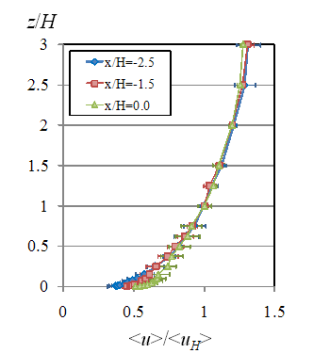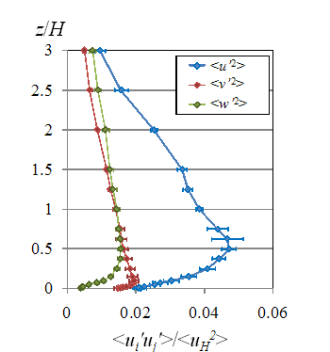
 |
 |
| (a) Mean Velocity | (b) Normal Stress(x/H=-2.5) |
Figure 2 Inflow Profile without a Model Building

| x, y, z | : three components of space coordinates (stream wise, lateral, vertical) | |
| <ζ> | : time averaged variable ζ | |
| ζ’ | : variation of variable ζ, ζ’= ζ−<ζ> | |
| σζ | : standard deviation of variable ζ | |
| H | : building height (0.2 m) | |
| u, v, w | : three components of the velocity vector (m/s) | |
| usc | : scalar velocity, usc= (<u>^2 + <v>^2 + <w>^2)^0.5 (m/s) | |
| <uH> | : <u> value at inflow of computational domain at height H (4.2 m/s) | |
| c | : gas concentration (ppm) | |
| q | : released gas emission amount (5.83x10^-6 m3/s) | |
| cgas | : released tracer gas concentration (1.0 x 10^6 ppm) | |
| c0 | : reference gas concentration,c0 = cgas q/<uH>H^2 (ppm) |
・Data file: Isothermal flow.xlsx -> Download this file
・Wind tunnel experiment result
(1) Mean Wind Velocity: <u>/<uH>
(2) Mean Wind Velocity: <v>/<uH>
(3) Mean Wind Velocity: <w>/<uH>
(4) Mean Scalar Wind Velocity: <usc>/<uH>
(5) Mean Wind Velocity Vector
(6) Normal Stress: <u’^2>/<uH^2>
(7) Normal Stress: <v’^2>/<uH^2>
(8) Normal Stress: <w’^2>/<uH^2>
(9) Turbulent Kinetic Energy : k/<uH^2>
(10) Mean Concentration : <c>/c0
(11) Standard Deviation of Concentration : σc/c0
(12) Advection Flux of Concentration : <u><c>/(<uH>c0)
(13) Advection Flux of Concentration : <v><c>/(<uH>c0)
(14) Advection Flux of Concentration : <w><c>/(<uH>c0)
(15) Turbulent Diffusion Flux of Concentration : <u’c’>/(<uH>c0)
(16) Turbulent Diffusion Flux of Concentration :<v’c’>/(<uH>c0)
(17) Turbulent Diffusion Flux of Concentration : <w’c’>/(<uH>c0)
The 4th International Symposium on Computational Wind Engineering, pp.549-552, June, 2006. [pdf]
[2] ISO, Guide to the Expression of Uncertainty in Measurement, 1993.
[3] L. Kirkup and B. Frenkel: An introduction to uncertainty in measurement, Cambridge University press, 2006
[4] The foundation of modern science and technology from the Physics Laboratory of NIST,
http://physics.nist.gov/cuu/Uncertainty/basic.html, (accessed 2005-10-22).
・ Mr. Tsuyoshi KOBAYASHI
・ Mr. Tetsuji MIDORIKAWA
・ Mr. Taigo SUGIMOTO
Wind Effects on Buildings and Urban Environment, Tokyo Polytechnic University